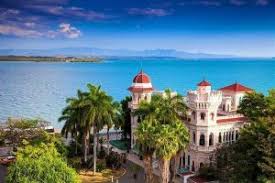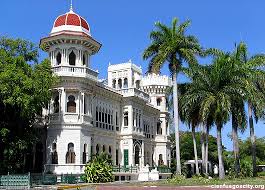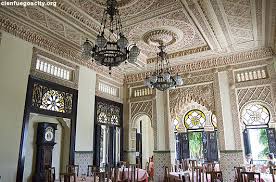 CIENFUEGOS, CUBA AND ITS MAGNIFICENT “PALACE DEL VALLE”.
CIENFUEGOS, CUBA AND ITS MAGNIFICENT “PALACE DEL VALLE”.
Cienfuegos is the capital of the province of Cienfuegos, a city on the south coast of Cuba and is located about 250 km (160 mi) from Havana and has a population of 150,000. The city is nicknamed La Perla del Sur (Pearl of the South). Cienfuegos literally translates as “one hundred fires”, which means “one hundred”, fires that means “fires”.
Cienfuegos, one of the main seaports of Cuba, is a center for trade in sugar, coffee and tobacco. While sugarcane is the main crop, local farmers also grow coffee.
Visiting Cienfuegos it is essential to walk along the boardwalk to the elegant Punta Gorda a sculpture park and where you can reach the well-known and magnificent ‘Palacio del Valle’, a huge pink building that looks like a rug thrown on it. If you take a detour where the pier ends, you can also reach the elegant ‘Club Cienfuegos’, all buildings erected by illustrious Cienfuegueros long before the current process arrived.
THE PALACE OF THE VALLEY, CULTURE NATIONAL MONUMENT.
When Acisclo del Valle began to build his mansion in 1913, he could not imagine that the installation would become a symbol of the Pearl of the South. The palace is located in the area of La Punta, National Monument of Cultural Heritage.
The land is located in Punta Gorda neighborhood and it was a wedding gift from Amparo Sr. Suero, when she married Acisclo, a rich businessman. It is rumored that the couple was on a trip to Spain when they decided to build a unique villa. They established their residence there and the works were completed in 1917, when the existing “Quinta Morisca” (Arab Villa) was extended. The designs were made by an architect from Cienfuegos and executed under the supervision of the Italian civil engineer Alfredo Colli Fanconetti.
The eclectic building was erected at a cost of half a million pesos and. French, Arab, Italian and Cuban artisans worked with marble, alabaster, bronze, glass and ceramics imported from Spain, Italy and the United States. Acisclo only enjoyed the Palace for 3 years. He died in 1920 and bequeathed to the State his wife and children 7.
A look at the central floor is quite surprising. It is flanked by two Egyptian sphinxes from the tales of animals, with the head and chest of a woman and the body and legs of a lion that personify the sun. However, some people claim that this is not supposed to be the main entrance. The entrance is of primitive Gothic style and leads to a dining room of Mudejar influence, which imitates the famous Patio de los Leones, of the Alhambra, in Granada. Then there is the music and games room, in the Louis XV style, and the imperial style lobby, with golden friezes, pink marble baseboards, bronze applications and the white marble floor. The second floor has 8 bedrooms, plus living and study rooms.
The initials of the owner are interwoven in an artistic monogram on the ceramic floor. Some interior and exterior columns are reminiscent of the mosque of Cordoba, in Spain. The building ends in 3 towers: Roman Gothic, Indian and Arab style reseda, in addition to a pergola on the roof. Italian and Chinese porcelain vases are scattered throughout the palace. It shows the opulence of bourgeois times in Cuba and a kind of construction that imitates foreign styles. They show us how Acisclo del Valle undertook the superb construction and let his imagination run freely.
It was abandoned in 1922, when the owner and his children traveled to Spain. Then, it became the Hunters Club for some time. It was taken over by Castro’s revolution in 1959, when it was later opened in an art school there.
 CIENFUEGOS, CUBA Y SU MAGNÍFICO PALACIO DEL VALLE. PHOTOS.
CIENFUEGOS, CUBA Y SU MAGNÍFICO PALACIO DEL VALLE. PHOTOS.
Cienfuegos es la capital de la provincia de Cienfuegos, una ciudad en la costa sur de Cuba y se encuentra a unos 250 km (160 mi) de La Habana y tiene una población de 150,000. La ciudad es apodada La Perla del Sur (Perla del Sur). Cienfuegos se traduce literalmente como “cien incendios”, que significa “cien”, fuegos que significa “incendios”.
Cienfuegos, uno de los principales puertos marítimos de Cuba, es un centro del comercio de azúcar, café y tabaco. Mientras que la caña de azúcar es el cultivo principal, los agricultores locales también cultivan café.
Visitando a Cienfuegos es esencial pasear por el malecón hasta la elegante Punta Gorda un parque de esculturas y donde podrás llegar al muy conocido y magnífico ‘Palacio del Valle’, un enorme edificio de color rosa que se parece a un tapete tirado en él. Si tomas un desvío donde termina el malecón podrás llegar al también elegante ‘Club Cienfuegos’, todos edificios erigidos por ilustres Cienfuegueros mucho antes que llegara el proceso actual.
EL PALACIO DEL VALLE, MONUMENTO NACIONAL A LA CULTURA.
Cuando Acisclo del Valle comenzó a construir su mansión en 1913, no podía imaginar que la instalación se convertiría en un símbolo de la Perla del Sur. El palacio está situado en la zona de La Punta, Monumento Nacional del Patrimonio Cultural.
El terreno está ubicado en Punta Gorda barrio y fue un regalo de boda de Amparo padre Suero, cuando se casó con Acisclo, un rico hombre de negocios. Se rumorea que la pareja estaba en un viaje a España cuando se decidió construir un chalet único. Establecieron su residencia allí y las obras concluyeron en 1917, cuando se amplió el existente “Quinta Morisca” (árabe Villa). Los diseños fueron hechos por un arquitecto de Cienfuegos y ejecutado bajo la supervisión del ingeniero civil italiano Alfredo Colli Fanconetti.
Se erigió el edificio ecléctico con un costo de medio millón de pesos y. Francés, los artesanos árabes, italianos y cubanos trabajaron con mármol, alabastro, bronce, vidrio y cerámica importados de España, Italia y Estados Unidos. Acisclo sólo disfrutaron del Palacio durante 3 años. Él murió en 1920 y legó al Estado a su esposa y los niños 7.
Un vistazo a la planta central es bastante sorprendente. Está flanqueada por dos esfinges egipcias de los cuentos de animales, con cabeza y pecho de mujer y cuerpo y patas de león que personifican el sol. Sin embargo, algunas personas aseguran que esto no se supone que es la entrada principal. La entrada es de estilo gótico primitivo y conduce a un comedor de influencia mudéjar, que imita el famoso Patio de los Leones, de la Alhambra, en Granada. Luego viene la sala de música y juegos, de estilo Luis XV, y el vestíbulo de estilo imperial, con frisos dorados, zócalos de mármol rosa, aplicaciones de bronce y el suelo de mármol blanco. La segunda planta cuenta con 8 dormitorios, además de estar y salas de estudio.
Las iniciales del propietario se entrecruzan en un monograma artística en el piso de cerámica. Algunas columnas interiores y exteriores recuerdan a la mezquita de Córdoba, en España.El edificio termina en 3 torres: Gothic romanos, indios y una reseda de estilo árabe, además de una pérgola en la azotea. Jarrones de porcelana italiana y china están dispersos por todo el palacio. Se evidencia la opulencia de tiempos burgueses en Cuba y una especie de construcción que imita estilos extranjeros. Ellos nos muestran cómo Acisclo del Valle emprendió la soberbia construcción y dejó correr su imaginación libremente.
Fue abandonado en 1922, cuando el propietario y sus hijos viajaron a España. Luego, se convirtió en el Club de Cazadores por algún tiempo. Fue tomada por la revolución de Castro en 1959, cuando se abrió más tarde en una escuela de arte allí.
Agencies/ Cuba Headlines/ Cienfuegos Monuments/ Internet Photos/ Arnoldo Varona/ www.Thecubanhistory.com
THE CUBAN HISTORY, HOLLYWOOD.







